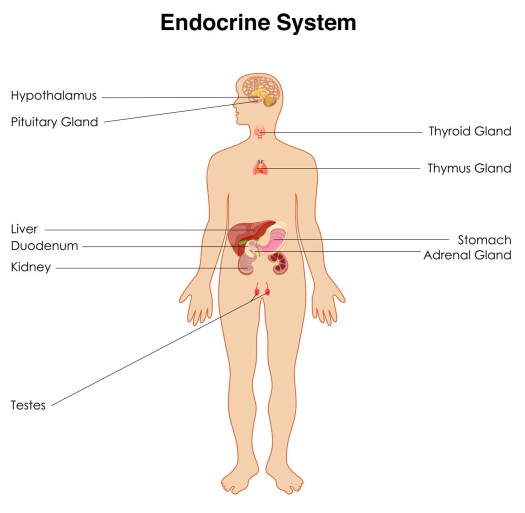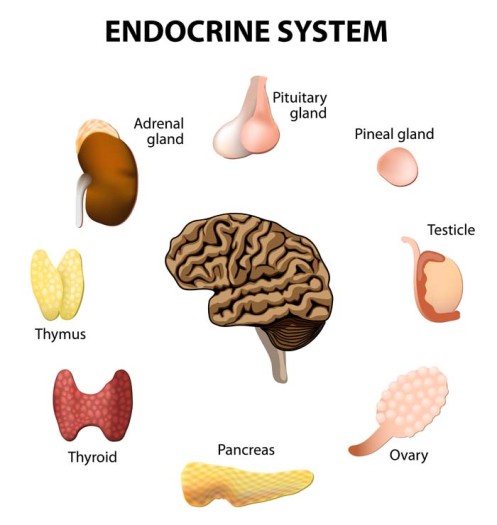 Endocrinology is a specialty of medicine; some would say a sub-specialty of internal medicine, which deals with the diagnosis and treatment of diseases related to hormones.
Endocrinology is a specialty of medicine; some would say a sub-specialty of internal medicine, which deals with the diagnosis and treatment of diseases related to hormones.
Endocrinology covers such human functions as the coordination of metabolism, respiration, reproduction, sensory perception, and movement. Endocrinology also focuses on the endocrine glands and tissues that secrete hormones.
The word “endocrinology” comes from the Greek endon meaning “within”, and the Greek krinein meaning “to separate”.
What is the endocrine system?
The human endocrine system consists of a number of glands. These glands produce and secrete hormones which control the body’s metabolism, growth, sexual development and function. When the hormones leave the glands they enter the bloodstream and are transported to organs and tissues in every part of the body.
Below is a list of glands in the human body and what they do:

The location of the major endocrine glands
Adrenal glands (suprarenal glands)
Located atop the kidneys. Adrenal glands are divided into 2 regions, the right gland is triangular while the left one is semilunar in shape. These glands secrete corticosteroids and catecholamines, such as norepinephrine and adrenaline (epinephrine), which are hormones that are released in response to stress.
The adrenal glands also produce androgens, male sex hormones that promote the development of male characteristics. Testosterone is the major androgen. These glands produce aldosterone which affects kidney function.
Hypothalamus
Located just above the brain stem, below the thalamus. This gland activates and controls involuntary body functions, appetite, sleep, temperature, as well as the circadian cycles. The hypothalamus links the nervous system to the endocrine system via the hypophysis (pituitary gland).
Ovaries and testicles
The ovaries, located on either side of the uterus in females, secrete the hormones estrogen and progesterone; these hormones ensure sexual development, fertility and healthy menstrual periods. The testicles, located in the scrotum below the penis in males, secrete androgens, mainly testosterone, that control sexual development, puberty, facial hair, sexual behavior, libido, erectile function, and the formation of spermatozoa (spermatogenesis).
Pancreas
Located in the abdomen. The pancreas is both an endocrine gland and a digestive organ. It produces insulin, somatostatin, glucagon, and pancreatic polypeptide. Insulin plays a key role in carbohydrate and fat metabolism in the body. Somatostatin regulates endocrine and nervous system function; it inhibits the secretion of several hormones, such as gastrin, insulin and growth hormone. Glucagon is a peptide hormone which raises blood glucose levels when they fall too low. Pancreatic polypeptide helps control the secretion of substances made by the pancreas. A peptide is a molecule that is made up of at least two amino acids.
Parathyroid glands
Small endocrine glands located in the neck. They produce parathyroid hormone, which regulates calcium and phosphorous in the blood, blood clotting, and neuromuscular excitation.
Pineal body (pineal gland)
A small endocrine gland located in the brain. It secretes melatonin, and is probably involved in controlling the body’s sleep patterns.
Pituitary gland
An endocrine gland located just off the hypothalamus at the base of the brain (a protrusion off the hypothalamus). Known as the main endocrine master gland, because it secretes hormones that regulate the functions of other glands, as well as growth and several body functions.
- The anterior pituitary secretes hormones that affect sexual development, thyroid function, growth, skin pigmentation, and adrenocortical function. If the anterior pituitary is underactive, it can lead to dwarfism in childhood and underactivity in other endocrine glands.
- The posterior pituitary secretes oxytocin, a hormone that raises uterine contractions as well as ADH (antidiuretic hormone) which encourages the reabsorption of water by the kidneys.
Thymus gland
An endocrine gland located beneath the breastbone (sternum). T lymphocytes, types of immune cells, mature and multiply in the thymus gland early in life. After puberty the gland shrinks. The thymus gland plays a role in the body’s immune system.
Thyroid gland
An endocrine gland located just below the Adam’s apple in the neck; it produces hormones that play a key role in regulatiing blood pressure, body temperature, heart rate, metabolism, and how the body reacts to other hormones. The thyroid gland uses iodine to manufacture hormones. The two main hormones are thyroxine and triiodythyronine. The thyroid gland also produces calcitonin, which stimulates bone cells to add calcium to bone, as well as regulating calcium metabolism.
Endocrine diseases
There are three broad groups of endocrine disorders:
1) Endocrine gland hyposecretion – when the gland is not producing enough. It can lead to hormone deficiency.
2) Endocrine gland hypersecretion – when the gland is overactive and produces too much. It can lead to excess levels of certain hormones.
3) Tumors of endocrine glands – these may be malignant (cancerous) or benign (non-cancerous).
Below are some examples of what may occur if a gland secretes too much or too little of its hormones:
Adrenal Gland
- Hypersecretion may lead to over-nervousness, sweating, raised blood pressure, and Cushing’s disease.
- Hyposecretion may lead to Addison’s disease, Mineralocorticoid deficiency, and diabetes.
 Pancreas
Pancreas
- Hypersecretion may lead to hyperinsulinism, too much insulin and not enough glucose gets to the brain.
- Hyposecretion may lead to diabetes.
Parathyroid Gland
- Hypersecretion may lead to brittle bones that fracture easily, as well as stones in the urinary system.
- Hyposecretion may lead to muscle tetany, caused by low levels of calcium in plasma.
Thyroid Gland
- Hypersecretion may lead to Graves disease, accelerated metabolism, sweating, arrhythmia (irregular heart beat), weight loss, and nervousness.
- Hyposecretion may lead to tiredness, weight gain, depression, abnormal bone development, mental retardation, and stunted growth.
Pituitary Gland
- Hypersecretion may lead to gigantism (excessive growth).
- Hyposecretion may lead to slow bone growth (dwarfism).
Thymus Gland
- Hypersecretion may lead to an overactive immune system.
- Hyposecretion may lead to a weakened immune system.
Ovary
- Hypersecretion may lead to exaggerated female traits.
Testicle
- Hypersecretion may lead to exaggerated male charecteristics.
What is an endocrinologist?
A doctor who specializes in endocrinology is an endocrinologist. they diagnose diseases that affect the glands mentioned above. An endocrinologist is an expert is treating frequently complex conditions which involved several different systems within the human body.
If patients visit their primary care physician (GP, general practitioner, family doctor), and he/she sustpects there is a problem with the endocrine system, they will be referred to an endocrinologist.
An endocrinologist diagnoses and treats hormone problems by attempting to restore hormone balance within the body’s system. The following diseases or disorders are commonly treated by endocrinologists: high blood pressure (hypertension), diabetes, osteoporosis, cholesterol problems, menopause, metabolic disorders, thyroid diseases, excessive or insufficient production of hormones, some cancers, short stature, and infertility.
To become an endocrinologist involves over 10 years of training.
For example, in the USA, becoming an endocrinologist involves:
- 4 years at college
- 4 years at medical school
- 3 years of residency
- 2 years of fellowship.
Arnold Adolph Berthold (1803-1861), a zoologist and physiologist from Germany, is seen as the “pioneer” of endocrinology. Berthold carried out experiments to determine the role of the gonads (ovary or testicles) in the development of secondary sexual characteristics.
Berthold noticed that when cockerels were castrated, they did not develop wattles (colored fleshy lobe hanging from the head or neck of cockerels) or combs (fleshy crest or ridge that grows on the crown of a cockerel), and lacked overtly male behavior. Medical historians say that it was at that moment that what we know as modern endocrinology was born.
Written by Christian Nordqvist and posted on MNT, July 20, 2015.
FAIR USE NOTICE: This site contains copyrighted material the use of which has not always been specifically authorized by the copyright owner. We are making such material available in our efforts to advance understanding of environmental, political, human rights, economic, democracy, scientific, and social justice issues, etc. We believe this constitutes a ‘fair use’ of any such copyrighted material as provided for in section 107 of the US Copyright Law. In accordance with Title 17 U. S. C. Section 107, the material on this site is distributed without profit to those who have expressed a prior interest in receiving the included information for research and educational purposes. For more information go to: http://www. law. cornell. edu/uscode/17/107. shtml“
